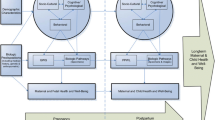Abstract
Objective
To examine maternal pre-pregnancy (preconception) predictors of birthweight and fetal growth for singleton live births occurring over a 2-year period in a prospective study.
Methods
Data are from a population-based cohort study of 1,420 women who were interviewed at baseline and 2-years later; self-report data and birth records were obtained for incident live births during the followup period. The analytic sample includes 116 singleton births. Baseline preconception maternal health status and health-related behaviors were examined as predictors of birthweight and fetal growth, controlling for prenatal and sociodemographic variables, using multiple regression analysis.
Results
Preconception BMI (overweight or obese) and vegetable consumption (at least one serving per day) had statistically significant independent and positive effects on birthweight and fetal growth. Maternal weight gain during pregnancy, a prenatal variable, was an additional independent predictor of birthweight and fetal growth. Sociodemographic variables were not significant predictors after controlling for preconception and prenatal maternal characteristics.
Conclusions
Findings confirm that preconception maternal health status and health-related behaviors can affect birthweight and fetal growth independent of prenatal and socioeconomic variables. Implications for preconception care are discussed.

Similar content being viewed by others
References
Centers for Disease Control and Prevention. (2006). Recommendations to improve preconception health and health care—United States: A report of the CDC/ATSDR Preconception Care Work Group and the Select Panel on Preconception Care. MMWR, 55(No. RR-6), inclusive page numbers.
Atrash, H. K., Johnson, K., Adams, M., Cordero, J. F., & Howse, J. (2006). Preconception care for improving perinatal outcomes: The time to act. Maternal and Child Health Journal, 10, S3–S11. doi:10.1007/s10995-006-0100-4.
Korenbrut, C. C., Steinberg, A., Bender, C., & Newberry, S. (2002). Preconception care: A systematic review. Maternal and Child Health Journal, 6, 75–88. doi:10.1023/A:1015460106832.
Anderson, J. E., Ebrahim, S., Floyd, L., & Atrash, H. (2006). Prevalence of risk factors for adverse pregnancy outcomes during pregnancy and the preconception period–United States, 2002–2004. Maternal and Child Health Journal, 10, S101–S106. doi:10.1007/s10995-006-0093-z.
Haas, J. S., Fuentes-Afflick, E., Stewart, A. L., Jacskon, R. A., Dean, M. L., Brawarsky, P., et al. (2005). Prepregnancy health status and the risk of preterm delivery. Archives of Pediatrics and Adolescent Medicine, 159, 58–63. doi:10.1001/archpedi.159.1.58.
Alexander, G. R. (2006). Prematurity at birth: determinants, consequences and geographic variation. In R. E. Behrman & A. S. Butler (Eds.), Preterm Birth: Causes, Consequences, and Prevention. Washington, D.C.: National Academies Press.
Lu, M. C., & Halfon, N. (2003). Racial and ethnic disparities in birth outcomes: A life-course perspective. Maternal and Child Health Journal, 7, 13–30. doi:10.1023/A:1022537516969.
Misra, D. P., Guyer, B., & Allston, A. (2003). Integrated perinatal health framework: A multiple determinants model with a life span approach. American Journal of Preventive Medicine, 25, 65–75. doi:10.1016/S0749-3797(03)00090-4.
Misra, D. P., & Grason, J. (2006). Achieving safe motherhood: applying a life course and multiple determinants perinatal health framework in public health. Women’s Health Issues, 16, 159–175. doi:10.1016/j.whi.2006.02.006.
Weisman, C. S., Hillemeier, M. M., Chase, G. A., Dyer, A. M., Baker, S. A., Feinberg, M., et al. (2006). Preconceptional health: Risks of adverse pregnancy outcomes by reproductive life stage in the central Pennsylvania women’s health study (CePAWHS). Women’s Health Issues, 16, 216–224. doi:10.1016/j.whi.2006.01.001.
Ventura, S. J., Abma, J. C., Mosher, W. D., & Henshaw, S. K. (2008). Estimated pregnancy rates by outcome for the United States, 1990–2004. National Vital Statistics Reports, 56(15), 1–25.
Ware, J. E., Kosinski, M., Turner-Bowker, D. M., & Gandek, B. (2002). How to score version 2 of the SF-12 Health Survey. Lincoln, RI: QualityMetric Incorporated.
Misra, D., O’Campo, P., & Strobino, D. (2001). Testing a sociomedical model for preterm birth. Paediatric and Perinatal Epidemiology, 15, 110–122. doi:10.1046/j.1365-3016.2001.00333.x.
Curry, M. A., Campbell, R. A., & Christian, M. (1994). Validity and reliability testing of the prenatal psychosocial profile. Research in Nursing and Health, 17, 127–135. doi:10.1002/nur.4770170208.
American College of Obstetricians and Gynecologists. (2002). Exercise during pregnancy and the postpartum period (Committee Opinion No 267). Obstetrics and Gynecology, 99, 171–173. doi:10.1016/S0029-7844(01)01749-5.
American College of Sports Medicine. (2000). ACSM’s guidelines for exercise testing and prescription (6th ed.). Philadelphia: Lippincott, Williams & Wilkins.
United States Department of Health and Human Services. (2008). 2008 Physical Activity Guidelines for Americans. Available at: www.health.gov/paguidelines.
Slattery, M. M., & Morrison, J. J. (2002). Preterm delivery. Lancet, 360, 1489–1497. doi:10.1016/S0140-6736(02)11476-0.
Wen, S. W., Smith, G., Yang, Q., & Walker, M. (2004). Epidemiology of preterm birth and neonatal outcome. Seminars in Fetal and Neonatal Medicine, 9, 429–435. doi:10.1016/j.siny.2004.04.002.
Frederick, I. O., Williams, M. A., Sales, A. E., Martine, D. P., & Killien, M. (2008). Pre-pregnancy body mass index, gestational weight gain, and other maternal characteristics in relation to infant birth weight. Maternal and Child Health Journal, 12, 557–567. doi:10.1007/s10995-007-0276-2.
Acknowledgments
This project was funded, in part, under grant number 4100020719 with the Pennsylvania Department of Health. The Department specifically disclaims responsibility for any analyses, interpretations or conclusions. The Penn State Survey Research Center conducted the telephone surveys. The Pennsylvania Department of Health provided the birth records.
Author information
Authors and Affiliations
Corresponding author
Rights and permissions
About this article
Cite this article
Weisman, C.S., Misra, D.P., Hillemeier, M.M. et al. Preconception Predictors of Birth Outcomes: Prospective Findings from the Central Pennsylvania Women’s Health Study. Matern Child Health J 15, 829–835 (2011). https://doi.org/10.1007/s10995-009-0473-2
Received:
Accepted:
Published:
Issue Date:
DOI: https://doi.org/10.1007/s10995-009-0473-2




